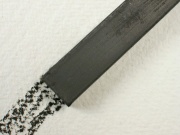Difference between revisions of "Charcoal crayon"
m (Text replace - "== Authority ==" to "== Sources Checked for Data in Record ==") |
|||
| Line 14: | Line 14: | ||
H.Stratis, "Compressed Charcoal" in Media & Techniques of Works of Art on Paper, New York University, 1999. | H.Stratis, "Compressed Charcoal" in Media & Techniques of Works of Art on Paper, New York University, 1999. | ||
| − | == | + | == Sources Checked for Data in Record == |
* Ralph Mayer, ''A Dictionary of Art Terms and Techniques'', Harper and Row Publishers, New York, 1969 (also 1945 printing) | * Ralph Mayer, ''A Dictionary of Art Terms and Techniques'', Harper and Row Publishers, New York, 1969 (also 1945 printing) | ||
Revision as of 13:50, 29 April 2016
Description
While charred sticks have been used since ancient times as a drawing tool, Charcoal crayons, were not developed until the mid 19th century. Charcoal crayons, or compressed charcoal, contain finely ground charcoal that has been pressed into sticks with little to no added binder (Stratis 1999). The sticks are fired then enclosed in soft wooden casings. Charcoal crayons produce a denser, darker color than charcoal sticks. Although its lines do not smear as readily as charcoal, they are still sprayed with a Fixative to prevent smudging.
Synonyms and Related Terms
charcoal pencil; charcoal stick; matita al carboncino (It.); lápis de carvão (Port.); compressed charcoal
Additional Information
H.Stratis, "Compressed Charcoal" in Media & Techniques of Works of Art on Paper, New York University, 1999.
Sources Checked for Data in Record
- Ralph Mayer, A Dictionary of Art Terms and Techniques, Harper and Row Publishers, New York, 1969 (also 1945 printing)
